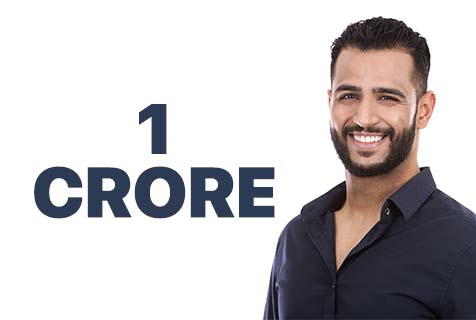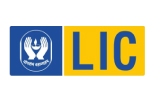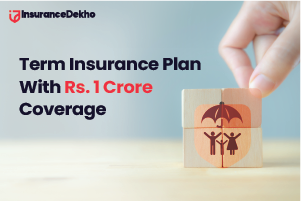Renewable vs Convertible Life Insurance Term Plans
Term life insurance provides peace of mind that your family will be well cared for in your absence. It ensures that they do not face any financial difficulty when you are gone.
When choosing a term insurance plan, you'll come across different types, such as renewable and convertible term plans. To choose one, you must understand the difference between these renewable vs convertible term life insurance plans, which we’ll explain in this blog.
Let’s begin!
Table of Contents
- What Is Renewable Term Life Insurance?
- How Renewable Term Life Insurance Works
- Pros and Cons of Renewable Term Insurance
- What Is Convertible Term Life Insurance?
- How Convertible Term Life Insurance Works
- Pros and Cons of Convertible Term Insurance
- Importance of Flexibility in Term Life Insurance Policies
- Renewable vs. Convertible Term Life Insurance
- Factors to Consider When Choosing Between Renewable and Convertible Term Plans
- Conclusion
- FAQs
What Is Renewable Term Life Insurance?
Renewable Term Life Insurance refers to the policies that can be renewed after the base coverage expires. These plans generally last for 5 to 30 years, but they can renewed as per specific individual needs.
The best part is that policyholders don't need to undergo any medical checkups at renewal.
It’s worth remembering that each time, the premium will be recalculated based on the insured’s age at the time of renewal. Renewable term insurance can be highly beneficial if your health is declining and the policy approaches expiration. However, for this feature, you need to pay a higher premium as the insurance company is taking more risk.
How Renewable Term Life Insurance Works
Let’s understand how renewable term life insurance works with an example:
- Neha is 35 years old, and she buys a 20-year term policy. So, the policy will provide her coverage till the age of 55. The annual premium for this policy is ₹10,000.
- At the end of the 20-year term, Neha can renew her policy for another 10 to 20 years, as per her needs.
- At the time of policy renewal, Neha doesn't have to go through another medical checkup, and she can enjoy the coverage in her 70s.
Pros and Cons of Renewable Term Insurance

Now, let’s explore the pros and cons of renewable-term insurance.
Pros of Renewable Term Insurance
- Continued coverage: With renewable term insurance, you can extend the plan coverage beyond the initial policy term without any medical exam. This can be extremely beneficial if you want to keep the policy as you age.
- Flexibility: This insurance policy gives you the flexibility to renew your policy for another term. It allows you to adjust your coverage based on your current goals and needs.
- Convenience: The renewable insurance policy also gives you the convenience of easily renewing your policy, which is much easier than starting a new one. You need to do less paperwork and no medical checkups.
Cons of Renewable Term Insurance
- Increased premiums: As you age, the cost of renewing your policy increases because the insurer is taking more risk. This means you need to pay much more premiums as you grow old.
- No cash value: The renewable insurance policy does not build any cash value or savings component with time. So, with this policy, you only receive coverage and no investment benefits.
- Limited coverage: As the renewable policy ends after a certain period, you can face gaps in the coverage. The policy does not cover you for an entire lifetime.
What Is Convertible Term Life Insurance?
Convertible term insurance allows the policyholder to convert their term insurance into a universal or permanent life insurance policy, such as a whole-life policy. Like renewable term insurance, one doesn’t have to go through any medical evaluation during policy conversion.
A convertibility clause must be included in the term insurance policy contract to access this benefit.
Imagine you purchased a term insurance policy initially because it was a more affordable option for you. But now your financial situation has improved and you want to commit to a whole life insurance. So, no matter if your health condition has changed, you’ll receive more advanced benefits with the conversion, but it comes with a higher premium.
How Convertible Term Life Insurance Works
Let’s understand how convertible life insurance works with an example.
- At age 35, Vijay purchases a 20-year convertible term life insurance policy with a coverage amount of ₹1 crore. His annual premium is ₹20,000.
- As Vijay approaches the end of the 20-year term, he decides to get lifelong coverage at the age of 45. Given that his policy is convertible, he opts to convert his term policy into a whole-life policy.
Pros and Cons of Convertible Term Insurance
Let’s understand the pros and cons of the convertible term life insurance.
Pros of Convertible Term Insurance
- Flexibility: The number one benefit of convertible term insurance is you can switch to a permanent policy without reapplying and without any medical exam. This helps you in securing long-term coverage later.
- Fixed premiums: When you convert your renewable to a permanent policy, then you only have to pay a fixed premium. This means that you don’t have to face the increasing cost of renewing the policy as you get older.
- Cash value: After changing to a permanent policy, you can accumulate cash value with time. You can use that for loans and withdrawals whenever needed. It provides you with more than the coverage benefit.
Cons of Convertible Term Insurance
- Limited conversion period: Some renewable policy term has a fixed time for conversion. After that time, you can’t convert it to a permanent policy. So, within the given time, if your financial situation doesn't allow, you’ll miss out on the conversion benefit.
- Higher premiums: Permanent policies usually have higher premiums than any term insurance policy. So, if you convert to a permanent policy, your insurance costs will significantly increase.
- Complexity: Term policies are much simpler than permanent policies. As the permanent policy has a lot more features and options, it can sometimes be hard to manage them efficiently.
Importance of Flexibility in Term Life Insurance Policies
Before we dive further, let’s figure out why flexibility is important in a term life insurance policy.
Adjust to life changes: Investing in term plans is a long-term commitment. Your life goals might change over time; you might get married, have children, or maybe buy a house. So, it's important to have a term insurance policy that allows you to adjust the coverage with time to match your current situation.
Provides financial flexibility: You never know how your financial situation will be in the future. So, it’s best to have a policy that lets you adjust the premiums or pause them if needed. This can be very beneficial if you are having a tough financial situation.
Extend the coverage: While buying the policy, if you are unsure about how long you will need the coverage, then having a renewable policy helps you to renew the coverage according to your needs.
Adapt to health changes: Flexibility in term insurance policy helps you adjust the coverage if your health changes over time.
Renewable vs. Convertible Term Life Insurance
Let’s find out the key differences between renewable vs convertible term life insurance.
|
Parameter |
Renewable Term Life Insurance |
Convertible Term Life Insurance |
|
Definition |
Allows renewal of the policy at the end of the term without a medical exam. |
Allows conversion of the term policy into a permanent policy without a medical exam. |
|
Premiums |
The premiums are low in the beginning, but they gradually increase with the policy renewal, and it mostly depends on your age and health |
The premium is higher than the renewal policy as it has the conversion feature, which provides you with lifelong benefits |
|
Flexibility |
The renewable policy has limited flexibility due to the policy renewal at the end of the term, and the premiums might increase with the renewal |
It has more flexibility as the policyholder can convert their policy into a whole-life one without reapplying for coverage |
|
Conversion |
The conversion option in the renewable term life policy is not available |
The conversion is possible without any medical checkup of the policyholder |
|
Renewal |
The policy can be renewed after the term period is over without having any medical evaluation of the policyholder. |
There is no need to renew the policy as it can be converted into a universal policy. |
Factors to Consider When Choosing Between Renewable and Convertible Term Plans
Let’s see the important factors that you need to consider before choosing between a renewable or convertible term insurance plan.
Future needs: Think about if you will need the insurance after a certain period. If required, you can opt for a convertible plan, as it allows you to switch to a universal policy later. If your future needs are limited, then go for the renewable term plan.
Cost of renewals: Before purchasing the policy, check how much the premium is increasing with the renewal. It mostly increases as you age. If the premiums of the renewal plan are too high, then go for the convertible plan as it will give you more benefits than the renewal one.
Health changes: Consider the fact that your health will change over time. So, choose a plan that fits your health. If your health deteriorates too much over time, then the conversion will be much more beneficial as it gives you the option to add riders to the policy to increase its coverage.
Age limit: Check how long the renewable policy will provide coverage and for how many years it can be renewed. If you are unable to renew it after reaching a specific age, you may find yourself without insurance in the later years.
Conclusion
While choosing between renewable and convertible term insurance plans, you need to consider your long-term financial goals and needs. The renewable term plan offers the flexibility to extend the policy coverage as you age but does not cover for an entire lifetime.
On the other hand, a convertible term plan gives you the benefit of switching to a universal plan and offers more features.
Before choosing between any of them, consider factors such as coverage needs, your health, and financial goals. Understand the difference between the two plans and then make a decision based on your personal goals.
FAQs
Ques 1. Is it very expensive to convert a term policy into a whole-life policy?
Ans. While converting a term policy into a whole-life or universal policy, you don’t need to pay any extra fee. But the premium amount may increase as the whole-life or universal policy will offer you more benefits and features.
Ques 2. What is the benefit of a convertible life insurance policy?
Ans. One of the most important benefits of a convertible insurance plan is that the insured person can change their term insurance policy into a universal policy without going through any medical tests.
Ques 3. Why is flexibility important in your term insurance policy?
Ans. The flexibility in term life insurance allows you to increase, decrease, or pause the premium amount without reapplying. It also allows you to adapt to significant life changes like getting married or buying a new house.
Ques 4. Renewable and convertible: which one is better?
Ans. It depends on an individual’s personal goals and needs. Before choosing between these two, consider several factors, such as your health, financial situation, and future goals. The renewable policy can be beneficial if you have short-term goals which convertible is good for long-term goals.
Ques 5. What is the benefit of renewable life insurance?
Ans. Renewable life insurance gives the policyholder the benefit of renewing their term policy after their term period is over. It allows them to continue enjoying their policy benefits.










































